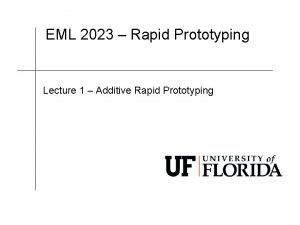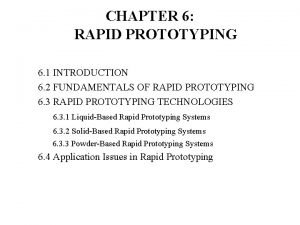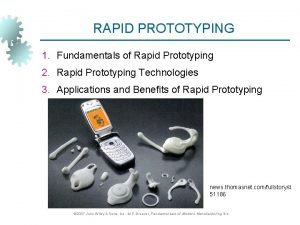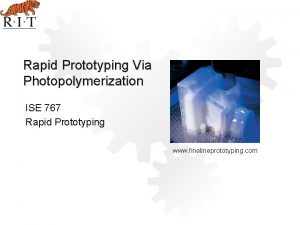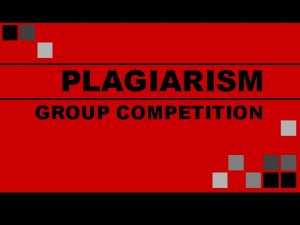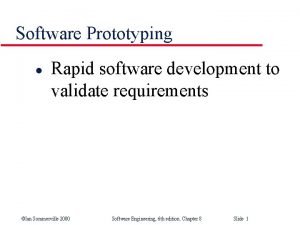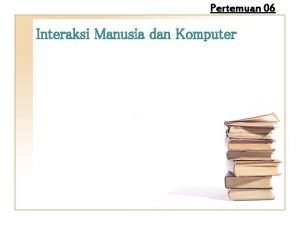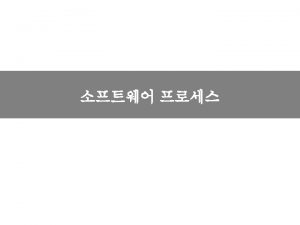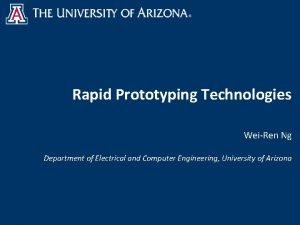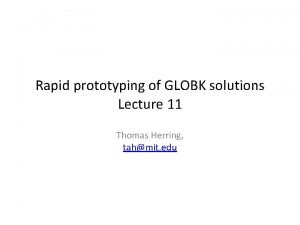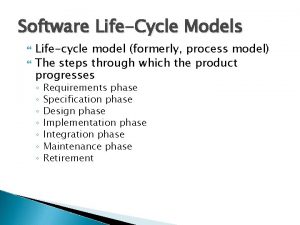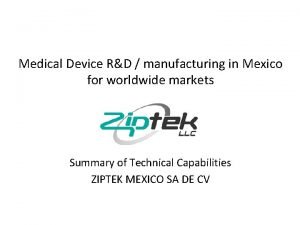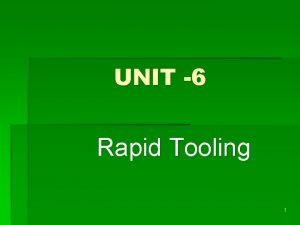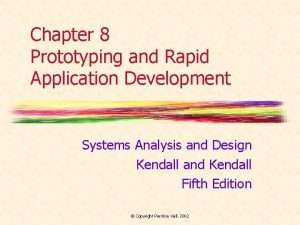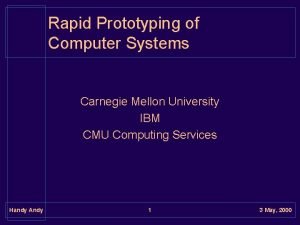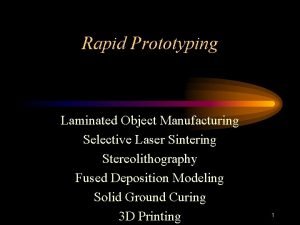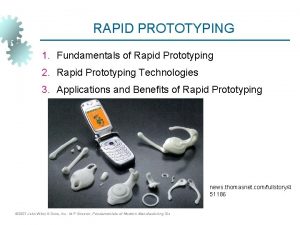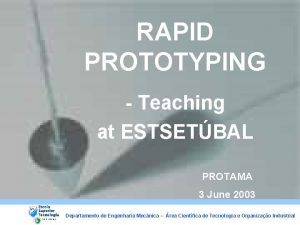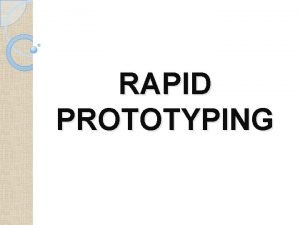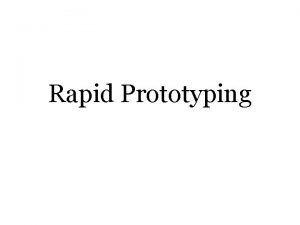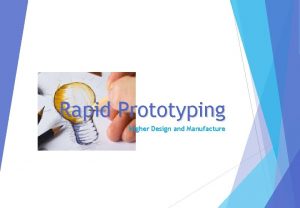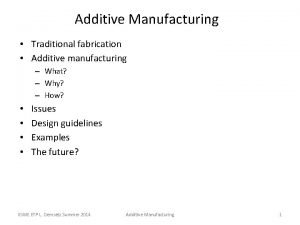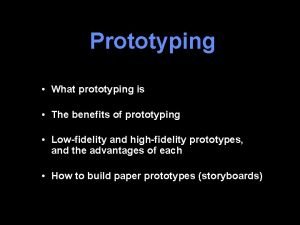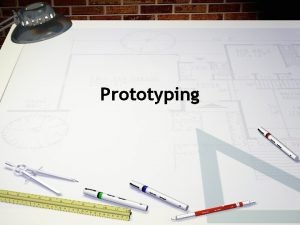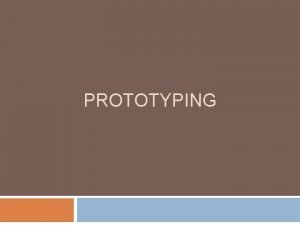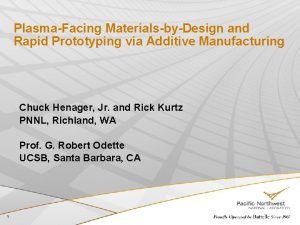1 What is Rapid Prototyping additive material Traditional

















- Slides: 17

1. What is Rapid Prototyping: additive material Traditional manufacturing: subtractive material

1. 1 Characteristics of RP § A technology that produces models and prototype parts from 3 D CAD model data, CT and MRI scan data, and model data created from 3 D object digitizing systems § RP systems join together liquid, powder and sheet materials to form parts Layer by layer, RP machines fabricate plastic, wood, ceramic and metal objects RP also known as Solid Freeform Fabrication (SFF) or Layer Manufacturing (LM)

1. 2 Basic process of RP Three stages: pre-processing, building, and post processing CAD Model Pre Process RP Process Post Process Surface/Solid Model Generate. STL file Build Prototype Remove Supports in CAD in RP systems Build Supports if needed Clean Surface Post Cure if needed Slicing Part Completed

1. 3 Benefits of RP Shorten time to market & reduced development cost THE COST OF CHANGE PHASE COST Conceptual modeling Detail design Prototype/test Manufacturing Product release $100 $1, 000 $100, 000 Source: Wohlers Associates Improved product quality RP enable more design iterations in a given time 3 D visualization of product designs Esure that customers have a clear understanding “A picture is worth a thousand words; a model is worth a thousand pictures. ”

2. Common types of RP l The first RP system was introduced in 1988 l Common types of RP technologies now: - Stereo. Lithography (SL) - Fused Deposition Modeling (FDM) - Selective Laser Sintering (SLS) - Laminated Object Manufacturing (LOM) - 3 D Printing (3 DP)

2. 1 Stereo-Lithography (SL) Scanning Mirror Re-coating Blade Cured resin to form model Liquid Resin Elevator & Platform Laser Supports 1. The elevator lowered by 1 layer deep; 2. The Blade sweep across the vat, apply an even layer of resin on top of the part; 3. As the laser beam strikes the resin surface, the liquid resin is hardened to a solid plastic; 4. Loop through the three steps to cure a new layer.

Stereo-Lithography Apparatus (SLA) Representative: from 3 D Systems, Inc. l Materials: photocurable resins l Adv. & Disadvantages: Good dimensional accuracy Good surface finish Narrow range of materials Relatively high cost Post curing l Application areas: - Prototypes for concept models; - Form-fit for assembly tests and process planning; - Models for investment casting, replacement of the wax pattern; - Patterns for metal spraying, epoxy molding and other soft tooling l

2. 2 Fused Deposition Modeling (FDM) Model & Support Filaments Part Support Heated extrusion head Elevator & Platform 1. Extrusion head and elevator move to start position; 2. The head extrude layer of support; 3. The head extrude layer of model; 4. Loop through the three steps to build the next layer.

Fused Deposition Modeling (FDM) l Representative: from Stratasys Inc. l Materials: thermoplastic material such as wax, ABS plastic & elastomer l Adv. & Disadvantages: clean, simple, easy to operate A good variety of material Mid range performance/cost Relative low accuracy Poor strength in vertical direction - Slow for building a mass part Application areas: - Conceptual modeling; - Fit, form and functional test; - Pattern for investment casting; - The MABS (methy methacrylate ABS) material is particularly suitable for medical applications. l

2. 3 Selective Laser Sintering (SLS) Scanning Mirror Laser Powder cartridges Piston Support Roller Part 1. Piston of the part built chamber lower by one layer; 2. Piston of powder cartridges raise up; 3. Roller spread powder evenly over the built surface; 4. Laser beam scan over the top of the part, melting the powder and fuse it to the previous layer; 5. Loop through the four steps to build the next layer. Build Chamber

Selective Laser Sintering (SLS) Representative: from DTM Corporation Expensive running cost Toxic gases generated Application areas: powder material such as nylon, - Visual representation; wax, polycarbonate, metal, - durable enough for most ceramic, elastomer, etc. functional tests; Adv. & Disadvantages: Large variety of material available - Pattern for making soft Produced in short time tooling, casting; No additional support required - Direct manufacture of metal No post curing required mould; Heat up powder & cool down part - Small batch production run. Smoothness of surface restricted Materials:

2. 4 Laminated Object Manufacturing (LOM) 1. The sheet material is stretched from the supply roller to the take-up roller; 2. The heated laminated roller passes over the sheet bonding it to the previous layer; 3. Laser cuts the profile of that layer and hatching the excess material for later removal; 4. Loop through the three steps to form a new layer.

Laminated Object Manufacturing (LOM) Representative: from Helisys Materials: sheet material such as paper, plastic, ceramic, composite etc. Adv. & Disadvantages: A relatively high speed process No post curing required No support structure required Simple to use The most commonly used material is only paper Must be post processed immediately Restricted to build complex parts Fire hazard occasionally happened Application areas: - Visual representation; - Concept modeling; - Pattern for sand casting;

2. 5 3 D Printing (3 DP) Companies install them in offices near their CAD systems for concept modeling. less costly and less capable variation of RP technology

3. Application cases of RP Common applications of the RP technology: l Design concept models l Marketing models for tenders, customer feedback, presentations and brochures l Test & Analysis functional testing; strong models for wind tunnel and stress analysis l Tooling masters and patterns for a broad range of manufacturing processes l Medicine artificial limbs, tools and instruments

4. Rapid Tooling Making (RTM) l INDIRECT RPM: Pattern created by RP used to fabricate tool - RP-fabricated part as master in making silicon-rubber mold (subsequently used as production mold) - RP patterns to make sand molds for sand casting - Fabrication of patterns of low-melting pt. materials for Investment casting l DIRECT RPM: RP used to make the tool itself - 3 D printing to create die geometry in metallic powders (followed by sintering & infiltration)

4. Rapid Tooling Making (RTM) l low volume (from tens to hundreds) - Soft Tooling Intermediate (from hundreds to thousands) - Metal filled Epoxy Tooling - Powdered Metal Tooling l Aluminum-filled epoxy mold, SL master, and molded thermoplastic parts
 Rapid prototyping data formats
Rapid prototyping data formats Eml 2023 uf
Eml 2023 uf Introduction to rapid prototyping
Introduction to rapid prototyping Liquid based rp system
Liquid based rp system Photopolymer
Photopolymer Rapid prototyping could be an advantageous methodology
Rapid prototyping could be an advantageous methodology Rapid prototyping techniques in software engineering
Rapid prototyping techniques in software engineering Bentuk awal contoh atau standar ukuran dari sebuah
Bentuk awal contoh atau standar ukuran dari sebuah Waterfall v model
Waterfall v model Rapid prototyping wiki
Rapid prototyping wiki Rapid prototyping
Rapid prototyping Rapid prototyping
Rapid prototyping Synchronize and stabilize model
Synchronize and stabilize model Mexico rapid prototyping
Mexico rapid prototyping Rapid prototyping pro metal system
Rapid prototyping pro metal system Prototyping and rapid application development
Prototyping and rapid application development Cmu rapid prototyping
Cmu rapid prototyping Lom rapid prototyping
Lom rapid prototyping

